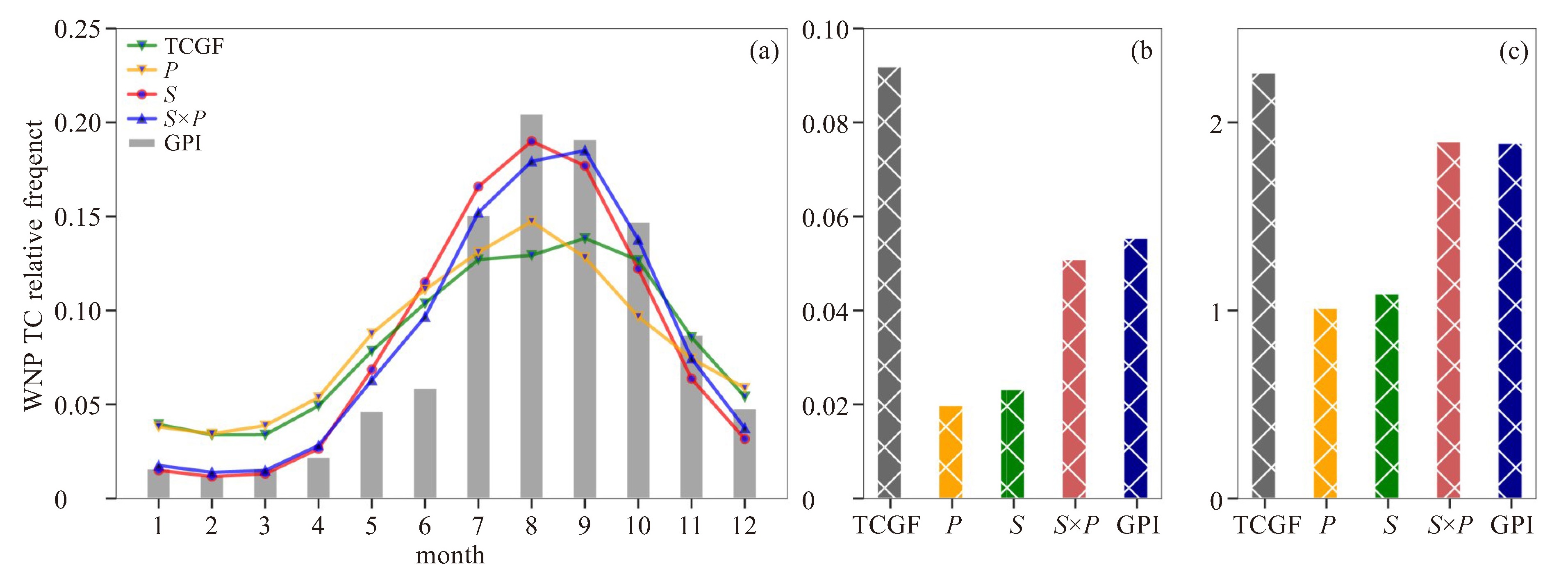Impact of Large-Scale Modulation of Seeds and Survival Rate on the Tropical Cyclone Genesis Frequency in the Northwestern Pacific
-
摘要: 大尺度环境是影响热带气旋(TC)生成数目气候特征的背景,但目前基于两者统计关系建立的TC潜在生成指数(Genesis Potential Tndex,GPI)对西北太平洋TC生成频数年循环的精确刻画有待提高。TC生成的理论框架将TC生成数目表示为TC前期扰动(TC胚胎)数和扰动发展为TC的概率的乘积。基于这一理论框架,采用国际气候管理最佳路径档案的热带气旋最佳路径数据和欧洲中期预报中心提供的ERA-5再分析资料,探究大尺度环境对西北太平洋TC生成频数气候特征的影响。结果表明,基于该理论框架提出的大尺度环境参数化的TC胚胎数与其存活率的乘积能够精细刻画西北太平洋TC生成频数的年循环特征。在整个西北太平洋区域,存活率和TC胚胎数的乘积与TC生成频数序列的相关并不显著。将西北太平洋分为东部和西部两个区域,两者都有显著的相关,并发现中国南海及菲律宾群岛一带(西部)TC生成频数异常由TC胚胎数和存活率共同调制,垂直速度和熵亏是调控二者的主要环境因子。在西北太平洋东部的广阔洋面上,TC生成频数异常主要受TC胚胎数变化的影响,垂直速度和相对涡度控制了TC胚胎数的变化。Abstract: The large-scale environment serves as the background influencing the climatic characteristics of tropical cyclone (TC) genesis frequency. However, current TC genesis potential indices (GPIs), which are based on statistical relationships between environmental factors and TC formation, still require improvement in accurately characterizing the annual cycle of TC genesis frequency over the Northwestern Pacific. According to the theoretical framework of tropical cyclogenesis, TC genesis frequency can be expressed as the product of precursor disturbances (TC seeds) and their probability of developing into TCs. Based on this theoretical framework, the present study utilized TC best track data from the International Best Track Archive for Climate Stewardship and ERA-5 reanalysis data provided by the European Centre for Medium-Range Weather Forecasts to investigate the impact of large-scale environmental conditions on the climatic characteristics of tropical cyclone genesis frequency in the Northwestern Pacific. The results indicate that, based on the proposed theoretical framework, the product of the parameterized TC seeds and their survival rate can effectively characterize the annual cycle of TC genesis frequency in the Northwestern Pacific. In the entire Northwestern Pacific region, the correlation between the product of the two factors and TC genesis frequency was not significant. However, after dividing the entire region into eastern and western parts, we found that the product of TC seeds and survival rate showed significant correlations with TC genesis frequency in both regions. It was also observed that in the western region around the South China Sea and the Philippines Sea, the abnormal tropical cyclone genesis frequency was primarily controlled by both TC seeds and their survival rate. Vertical velocity and entropy deficit were identified as primary environmental factors affecting these two factors. Over the vast eastern Northwestern Pacific, on the other hand, the abnormal tropical cyclone genesis frequency was mainly influenced by variations in TC seeds, which were controlled by vertical velocity and relative vorticity.
-
图 8 同图 7,为140 °E以东区域
表 1 1979—2021年不同区域内TC生成频数和不同指数之间的相关系数
Index 100~140°E 140°E~180° S 0.65* 0.61* P 0.40* 0.20* S×P 0.60* 0.54* GPI 0.34* 0.15 注:*表示通过表示通过0.05的显著性水平。 表 2 TCGF正、负异常年TC胚胎指数和存活率变化对S×P的贡献
异常
年份140°E以西区域 140°E以东区域 年份 胚胎数 存活率 δ(S×P) 年份 胚胎数 存活率 δ(S×P) 正异
常年1995 +0.24(36.1%) +0.43(63.9%) +0.67 1980 +0.16(69.8%) +0.07(30.2%) +0.23 1998 +0.11(13.9%) +0.71(86.1%) +0.82 1989 +0.44(203.7%) -0.22(-103.7%) +0.22 2000 +0.43(85.9%) +0.07(14.1%) +0.50 1991 +0.55(133.0%) -0.14(-33.0%) +0.42 2013 +0.15(52.6%) +0.14(47.4%) +0.29 1994 +0.54(145.7%) -0.17(-45.7%) +0.37 2017 +0.15(38.3%) +0.24(61.7%) +0.39 2002 +0.58(104.7%) -0.03(-4.7%) +0.56 2020 +0.24(24.2%) +0.79(75.8%) +0.99 2004 +0.16(20.2%) +0.64(79.8%) +0.80 Ave. 41.8% 58.2% 2016 +0.22(49.7%) +0.22(50.3%) +0.44 2018.00 +0.07(26.5%) +0.21(73.5%) +0.28 Ave. 94.2% 5.8% 负异
常年1980 -0.007(5.2%) -0.127(94.8%) 0.134 1998 -0.53(47.9%) -0.58(52.1%) -1.11 1982 -0.27(30.0%) -0.63(70.0%) -0.90 1999 -0.20(17.6%) -0.95(82.4%) -1.15 1986.00 -0.16(38.7%) -0.30(61.3%) -0.46 2008 -0.49(91.1%) -0.048(8.9%) -0.54 1987 -0.305(100.0%) +0.00(0%) -0.305 2010 -0.75(57.1%) -0.56(42.9%) -1.31 2002 -0.06(19.6%) -0.23(80.4%) -0.29 2020 -0.86(171.3%) +0.36(-71.3%) -0.50 2004 -0.39(92.7%) -0.03(7.3%) -0.42 Ave. 77.0% 23.0% 2014.00 -0.07(38.9%) -0.11(61.1%) -0.18 2015.00 -0.37(38.6%) -0.60(61.4%) -0.97 Ave. 0.46 0.55 -
[1] CHEN T C, WANG S Y, YEN M C. Interannual variation of the tropical cyclone activity over the western North Pacific[J]. J Climate, 2006, 19(21): 5 709-5 720. [2] 卢莹, 赵海坤, 赵丹, 等. 1984-2017年影响中国热带气旋灾害的时空特征分析[J]. 海洋学报, 2021, 43(6): 45-61. [3] VECCHI G A, DELWORTH T L, MURAKAMI H, et al. Tropical cyclone sensitivities to CO2 doubling: roles of atmospheric resolution, synoptic variability and background climate changes[J]. Climate Dyn, 2019, 53(9): 5 999-6 033. [4] HSIEH TL, VECCHI G A, YANG W, et al. Large-scale control on the frequency of tropical cyclones and seeds: a consistent relationship across a hierarchy of global atmospheric models[J]. Climate Dyn, 2020, 55(11): 3 177-3 196. [5] YANG W, HSIEH T L, VECCHI G A. Hurricane annual cycle controlled by both seeds and genesis probability[J]. Proc Natl Acad Sci USA, 2021, 118(41): e2108397118. [6] HSIEH T L, YANG W, VECCHI G A, et al. Model spread in the tropical cyclone frequency and seed propensity index across global warming and ENSO - Like perturbations[J]. Geophy Res Letts, 2022, 49(7): e2021GL097333. [7] GRAY W S. Hurricanes: Their formation, structure and likely role in the tropical circulation[C]//Shaw D B. Meteorology over the Tropical Oceans. Brcknell, Berkshire: Royal Meteorological Society, 1979: 155-218. [8] 赵晓彤, 余锦华, 廖桉桦, 等. 北大西洋热带气旋生成频数变化对海温异常响应特征的研究[J]. 热带气象学报, 2020, 36(2): 208-218. [9] 陈慕妍, 陈锐丹. 夏季西北太平洋热带气旋生成频次与热带海温关系的年代际变化[J]. 热带气象学报, 2022, 38(1): 58-67. [10] 杜新观, 余锦华. ENSO发展年与衰减年夏季环境要素对热带气旋生成频数变化的贡献[J]. 热带气象学报, 2020, 36(2): 244-253. [11] EMANUEL K, NOLAN D. Tropical cyclone activity and global climate[J]. Bull Amer Meteor Soc, 2004, 85: 240-241. [12] BISTER M, EMANUEL K A. Dissipative heating and hurricane intensity[J]. Meteor Atmos Phys, 1998, 65(3): 233-240. [13] 陶丽, 张艺帆, 王学兵. 南海与西北太平洋地区夏季热带气旋潜在生成指数的改进[J]. 大气科学学报, 43(4): 603-616. [14] MURAKAMI H, WANG B. Future change of north atlantic tropical cyclone tracks: projection by a 20-km Mesh global atmospheric model [J]. J Climate, 2010, 23(10): 2 699-2 721. [15] WANG B, MURAKAMI H. Dynamic genesis potential index for diagnosing present day and future global tropical cyclone genesis[J]. Environ Res Lett, 2020, 15(11): 114008. [16] TANG B, EMANUEL K. A ventilation index for tropical cyclones[J]. Bull Amer Meteor Soc, 2012, 93(12): 1 901-1 912. [17] IKEHATA K, SATOH M. Climatology of tropical cyclone seed frequency and survival rate in tropical cyclones[J]. Geophy Res Lett, 2021, 48(18): e2021GL093626. [18] YAMADA Y, KODAMA C, SATOH M, et al. Evaluation of the contribution of tropical cyclone seeds to changes in tropical cyclone frequency due to global warming in high resolution multi-model ensemble simulations[J]. Prog Earth Planet Sci, 2021, 8(1): 11. [19] HSIEH T L, ZHANG B, YANG W, et al. The influence of large-scale radiation anomalies on tropical cyclone frequency[J]. J Climate, 2023, 36(16): 5 431-5 441. [20] KNUTSON T, CAMARGO S J, CHAN J C L, et al. Tropical cyclones and climate change assessment: Part II: Projected Response to Anthropogenic Warming[J]. Bull Amer Meteor Soc, 2020, 101(3): E303-E322. [21] EMANUEL K. Tropical cyclone seeds, transition probabilities, and genesis[J]. J Climate, 2022, 35(11): 3 557-3 566. [22] SUGI M, YAMADA Y, YOSHIDA K, et al. Future changes in the global frequency of tropical cyclone seeds[J]. Sola, 2020, 16: 70-74. [23] SOBEL A H, WING A A, CAMARGO S J, et al. Tropical cyclone frequency[J]. Earth's Future, 2021, 9(12): e2021EF002275. [24] 周旭, 余锦华, 王志福. 西北太平洋热带气旋频数的气候变化及其与环境要素间的联系[J]. 气象科学, 2013, 33(1): 43-50. [25] YU W, LI Z, LI T, et al. Bimodal character of cyclone climatology in the bay of bengal modulated by monsoon seasonal cycle[J]. J Climate, 2013, 26(3): 1 033-1 046. -






 下载:
下载:









 粤公网安备 4401069904700003号
粤公网安备 4401069904700003号